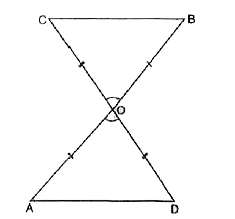आकृति में, OA = OB और OD = OC है, तो ΔAOD≅ΔBOC किस नियम पर आधारित है ?

भुजा-कोण-भुजा सर्वांगसमता
कोण-भुजा-कोण सर्वांगसमता
भुजा-भुजा-भुजा सर्वांगसमता
समकोण-कर्ण-भुजा सर्वांगसमता
The correct Answer is:A
Step by step video, text & image solution for आकृति में, OA = OB और OD = OC है, तो DeltaAOD~=DeltaBOC किस नियम पर आधारित है ? by Maths experts to help you in doubts & scoring excellent marks in Class 9 exams.
Topper's Solved these Questions
- BOOK - DEEPAK PUBLICATIONCHAPTER - त्रिभुजEXERCISE - अभ्यास के लिए ( रिक्त स्थान भरें )5videos
त्रिभुज
- BOOK - DEEPAK PUBLICATIONCHAPTER - चतुर्भुज EXERCISE - अध्याय का तीव्र अध्ययन22videos
चतुर्भुज
- BOOK - DEEPAK PUBLICATIONCHAPTER - दो चरों वाले रैखीय समीकरण EXERCISE - अध्याय का तीव्र अध्ययन35videos
दो चरों वाले रैखीय समीकरण
Similar Questions
एक त्रिभुज की तीनों भुजाएँ दूसरे त्रिभुज के तीनों भुजाओं के बराबर हों तो दोनों त्रिमज सर्वांगसम होंगे नियम-
06:07View Solutionचार भुजाओं से घिरी बंद आकृति को कहा जाता है
02:11View Solutionयदि a, b और c वास्तविक संख्याएँ हों तो निम्नलिखित में से कौन-सा समीकरण दो चरों वाला रैखिक समीकरण होगा-
01:31View SolutionWhich of the following are correct chain isomers of butane ? (i)
02:45View SolutionDetermine the point of symmetry of a regular hexagon.
02:17View SolutionDtermine the images of the following figure about the given line :
05:41View SolutionMatch the following Column A to Column B
 02:10View Solution
02:10View SolutionMatch the following Column A to Column B
 02:17View Solution
02:17View SolutionMatch the following Column A to Column B
 02:10View Solution
02:10View SolutionThe inequation represented by the graph given below is :
04:23View SolutionThe inequation that best describes the graph given below is _________
01:19View SolutionThe inequation that best describes the following graph is _________
01:53View SolutionWhich inequations represent the shaded region in the given figure
01:28View SolutionWhat is the distance OA for the square shown in figure :- ltimg src="https://d10lpgp6xz60nq.cloudfront.net/physics_images/ALN_PHY_R05_E01_015_Q01.png" width="80%"gt
01:45View SolutionThe resultant of the three vectors ¯¯¯¯¯¯OA,¯¯¯¯¯¯OB and ¯¯¯¯¯¯OC shown in figure :-
ltimg src="https://d10lpgp6xz60nq.cloudfront.net/physics_images/ALN_PHY_R01_E02_023_Q01.png" width="80%"gt04:02View Solution

